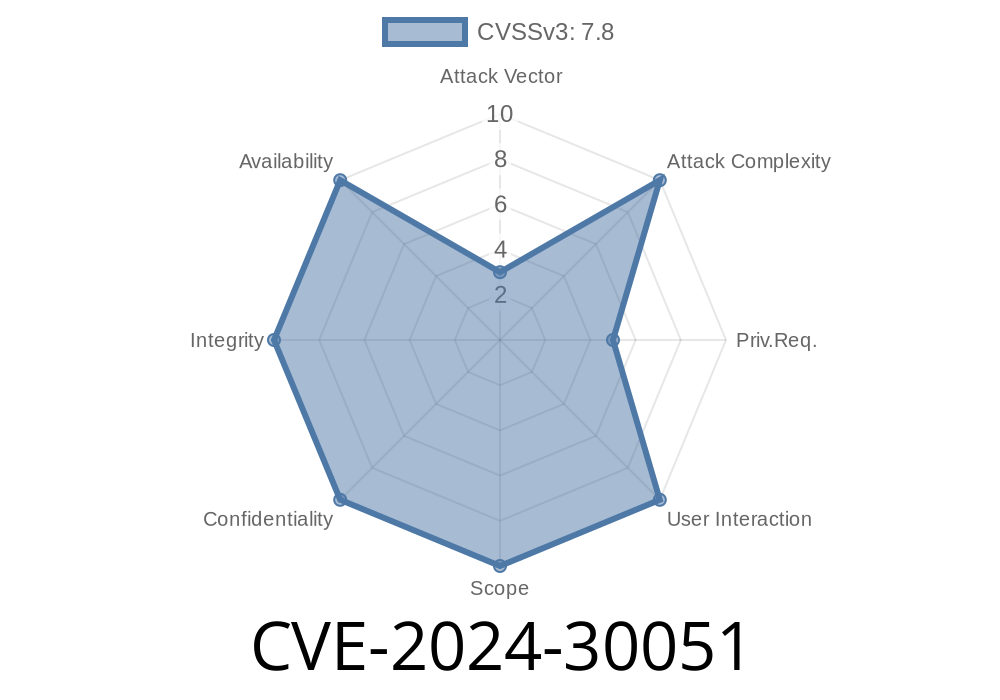In May 2024, Microsoft patched a critical vulnerability tracked as CVE-2024-30051, found in the Windows Desktop Window Manager (DWM) Core Library. This bug enables elevation of privilege—a fancy way of saying attackers can turn a “regular” user account into an administrator—on essentially all supported Windows versions. Here’s a deep dive into how the exploit works, some example code, and what you need to know to keep your systems secure.
What is DWM, and Why Does It Matter?
The Desktop Window Manager (DWM) is responsible for managing visual effects on desktops and the rendering of application windows. As a privileged Windows process, it’s a juicy target: code running in this component can interact with almost anything on the user’s screen, and as past vulnerabilities have shown, bugs here can escalate to SYSTEM—the highest level of privilege on Windows systems.
What’s The Bug?
CVE-2024-30051 is an elevation of privilege (EoP) vulnerability. An attacker who can execute code in DWM’s process context can potentially leverage this bug to run code as SYSTEM.
CVSS Score: 7.8 (High)
- Affected Systems: Windows 10/11, Windows Server 2019/2022, and others
Patch Release: May 14, 2024 (Patch Tuesday)
- Attack Complexity: Low. Exploitation is believed to be straightforward given code execution capability.
Root Cause
The vulnerability arises from improper input validation and object handling within the DWM Core Library (dwmcore.dll). Specifically, insecure handling of pointers and user-mode objects leads to a write-what-where condition, which attackers can leverage to overwrite sensitive kernel data structures. This allows privilege escalation.
The Exploit Flow
1. Gain User Access: The attacker tricks or lures a regular user (or leverages malware) to run a specially crafted executable.
2. Interact With DWM: The exploit interacts with DWM APIs or window objects, forcing DWM to reference malicious pointers or objects.
3. Arbitrary Write: By crafting bogus objects and leveraging the bug, the attacker rewrites critical fields—such as a process token pointer—to gain SYSTEM rights.
Real-World Usage
Researchers have already found CVE-2024-30051 being exploited in the wild by threat actors delivering ransomware and spyware.
Example Exploit Code (Simplified)
Below is a conceptualized example (not a full, weaponized exploit) to demonstrate how one might leverage similar user-mode to SYSTEM elevation in previous DWM bugs.
#include <windows.h>
#include <stdio.h>
// Replace with actual DWM trigger code as appropriate for CVE-2024-30051
int main() {
HWND fakeWindow = CreateWindowEx(
, "STATIC", "FakeWindow", WS_VISIBLE,
100, 100, 200, 100, NULL, NULL, GetModuleHandle(NULL), NULL);
// Code leveraging vulnerable DWM call:
// This is a placeholder; in real exploits, complex crafting of messages follows
for (int i = ; i < 100; i++) {
SendMessage(fakeWindow, WM_SETREDRAW, , );
// Real exploits would trigger a heap spray or similar technique
}
printf("Exploit attempt completed.\n");
return ;
}
Note: This code simply demonstrates interacting with a window; the actual exploit for CVE-2024-30051 is more complicated, but involves similar manipulation of window messages and DWM-exposed objects.
Is My System Vulnerable?
If you haven’t applied the May 2024 Patch Tuesday updates, yes!
Patch Now!
Microsoft Security Update Guide: CVE-2024-30051
References & Further Reading
- Microsoft’s Official Advisory for CVE-2024-30051
- Google Threat Analysis Group blog: Exploitation in the Wild (May 2024)
- Kaspersky Securelist: May 2024 Exploit Roundup
- MITRE CVE entry
Final Words
CVE-2024-30051 proves, once again, how even low-complexity UI bugs can be powerful weapons for attackers if left unpatched. Make sure to update your Windows systems immediately and remind others that “Patch Tuesday” is still the best day of the month.
Timeline
Published on: 05/14/2024 17:17:21 UTC
Last modified on: 05/16/2024 20:27:22 UTC
